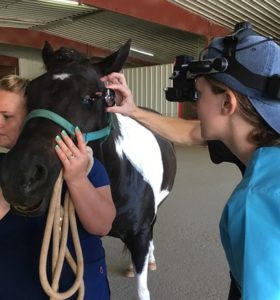What’s in an Externship?

What does a veterinary student do during their limited summer breaks? Anything that looks a lot like school without actually being more school, of course.
I chose to work in a few hospitals and also extern in a few hospitals. What’s an externship? Well, it’s two or more weeks of total immersion into a practice, which allows students to try and figure out if that practice or career path will be a good option for them. All fourth-year students at A&M complete somewhere between two and 12 weeks of externships at clinics all over the state and, sometimes, the world. I picked three different equine hospitals across the state and spent a few weeks this summer trying to figure out if being a horse vet is a good idea.
The first externship was still technically during breeding season and, as with most things involving babies, very little sleep was had. Every mare that came into the hospital was outfitted with an alert system so that the doctors and interns would know when she was starting to give birth. The process is pretty quick in normal horses, so when that alarm went off, it was “throw your boots on and run to the barn” and “hope you make it in time in case anything goes wrong.” The first foal delivery I was involved in decided to arrive at 4:00 in the morning. It was adorable and everything went perfectly, but it was a good reminder that horse vets (and horse vet interns, in particular) don’t really know the meaning of the word sleep between February and April. Having said that, it felt like I learned more in those few weeks than the entire previous semester.
The second externship was a whirlwind of surgery, lameness exams, and pregnancy checks. It was at an enormous hospital where each doctor is given their niche, and the sheer volume of patients they see meant that there were too many things going on for me to see them all. I generally tried to live in the operating room, as equine surgery was something I’d never really gotten a chance to see before. I saw surgeons work on colic cases, angular limb deformities, cryptorchid castrations, kissing spines, subchondral bone cysts, laryngeal hemiplegia, and on and on. In the short time I was there I was able to witness and assist with more and more diverse surgeries than I’ve ever seen in small animal practice or at school.
One day, a boarded veterinary ophthalmologist came by to take a look at a few patients with more complicated ocular disease. On a patient with unilateral glaucoma, he was able to take a good chunk of time and show the other extern and me how to do a thorough eye exam and the signs of disease in that particular horse. It was really nice to have that detailed explanation and hands-on experience before coming back to school to study equine ophthalmic diseases in the fall.
The third externship taught me more about herd health than I expected equine practitioners needed to know. Several clients owned dozens, if not hundreds, of horses, and managing them from a veterinary perspective became less about the needs of the individual horse and more about how to keep then entire group healthy. We spent an entire day driving around one property checking on different age groups of horses. Each little herd got a thorough distance exam, and those that stood out as being abnormal were inspected more closely and scheduled for diagnostics or treatments, as needed. This way problems needing medical attention were taken care of, but every individual horse did not have to have a full workup.
Every externship is different, and each of these taught me something new about being an equine practitioner. I’m still not sure if I want to be an equine vet, but now I feel like I have a good idea of what the day-to-day life involves.
